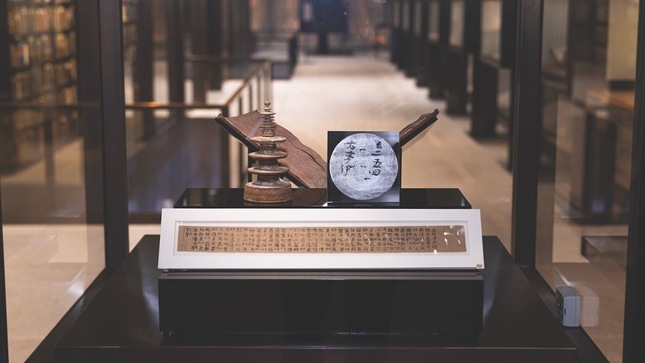
Beinecke Library. Photo by Andrew Hurley.
A Japanese scroll from around 770 CE—along with the miniature pagoda built to house it—now shares a display case with Yale’s Gutenberg Bible at the Beinecke Library. Almost 700 years before Gutenberg was born, Empress Shotoku of Japan commissioned a million mass-produced scrolls of several short Buddhist texts.
View full image

Beinecke Library. Photo by Andrew Hurley.
A Japanese scroll from around 770 CE—along with the miniature pagoda built to house it—now shares a display case with Yale’s Gutenberg Bible at the Beinecke Library. Almost 700 years before Gutenberg was born, Empress Shotoku of Japan commissioned a million mass-produced scrolls of several short Buddhist texts.
View full image
Only two permanent exhibits grace the Beinecke Library’s magnificent mezzanine, which is lit by the glowing veins of enormous marble windows. To the left of the main entrance, visitors can find John James Audubon’s original Birds of North America—two massive volumes of watercolors. A small bronze case to the right housed, until recently, both volumes of Johannes Gutenberg’s 1455 Bible. Today, a single volume sits across from another important document in the history of printing: an eighth-century Buddhist text, displayed along with the wooden pagoda in which it was originally enclosed.
Most people, if they’ve heard of Gutenberg’s Bible at all, are likely to tell you it was the first printed book. The updated text of the Beinecke exhibit claims a less pithy but more accurate form of primacy for this edition, calling it “the first surviving European printed book made using movable metal type.” The note now acknowledges not only Donatus, the Latin textbook Gutenberg probably printed before embarking on the massive Bible project, but also the much longer history of print in East Asia before the technology spread to Europe.
The new addition to this exhibit case emphasizes that history. It is a single printed scroll, part of an edition known as the Hyakumanto Dharani. One million copies of this set of short Buddhist texts were commissioned by the Japanese Empress Shotoku around 770 CE, each copy housed in a handmade wooden pagoda. Originally painted white, these pagodas mimic the shape of a stupa, a structure built in ancient India to house physical remains of the Buddha.
Dharani are neither scriptures nor prayers, but incantations whose very sounds are thought to have mystical power. Although the dharani displayed at Beinecke is written in the Chinese script, the characters represent sounds rather than words. Dharanis are often recited aloud, but these particular texts would never have been removed from the pagodas which housed them. Yale professor Eric Greene, who specializes in the history of medieval Chinese Buddhism, explains that “written dharani such as this were themselves potent ‘power objects,’ equivalent to bodily relics of the Buddha.” Like a relic, the printed scroll itself was thought to carry spiritual power, regardless of whether it was ever read.
The scale of production of the Hyakumanto Dharani is enormous and unprecedented, and scholars are still debating how exactly they were made. Though some say the texture of the ink is characteristic of woodblock prints, others argue that the dharani were printed from metal plates cast in a clay mold. Though this was not the first use of print technology for mass-producing texts, it is the earliest currently extant printed text that can be reliably dated.
Four of these pagodas and prayer scrolls were acquired by Asakawa Kan’ichi ’02PhD, a history professor and curator of Yale’s East Asian collections, in 1934. The presence of these texts next to the Gutenberg Bible is an important reminder that printing was well developed in East Asia long before it caught on in early modern Europe. Woodblock printing (sometimes called xylography) emerged in the Tang dynasty of China between 712 and 756, followed by movable porcelain and metal type in the eleventh and twelfth centuries. Movable type did not revolutionize printing in East Asia the way it would in Europe, possibly because it is a far less efficient system for character-based languages than alphabetic ones.
As Beinecke curator Raymond Clemens puts it: “Nobody denies the hugely important role Gutenberg played in the making of the modern world, but he did not create printing out of whole cloth. . . . The concept had existed for a very long time. We hope that pairing the Gutenberg Bible with an important artifact from another culture, and representing another major religious tradition, will inspire people to want to learn more about both objects and the fascinating history they represent.” The Beinecke’s exhibition hall is free and open to the public seven days a week, making it easy for visitors to do just that.
 loading
loading